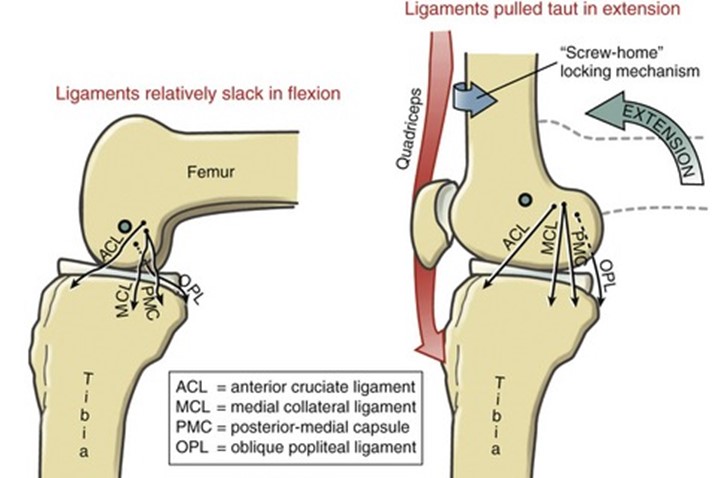Two of the most significant joints in a person’s body are the knees. Besides providing support to an individual’s weight, the knees also enable different routine activities for example standing up and sitting down, climbing stairs and walking. Due to such frequent usage of the knee joints, they are very much prone to degeneration and injury. Both of these can result in a locked knee. Momentary locking up of knees (commonly called as the locked knee) inhibits one’s ability to move them in any of the directions. This phenomenon can also be explained as “catching”, a feeling experienced when one’s knee gets caught during flexion or extension or the knee joints “giving out” as a popping sensation along with any knee movement. Unfortunately, there exists no secret formula or trick to unlock the knee joints. There are several treatments and physical therapy regimen which might help relieve the knee locking symptoms.
A relatively complex joint, the human knees are composed of multiple bones, tendons, ligaments and cartilage. The knee joints are primarily formed from the bones while the tendons and muscles act around these bones for the articulation of the joint. The ACL or anterior crucial element ligament and other ligaments exist for providing stability and their work is to make sure that the knees only move in the manner they are supposed to. The cartilage, known as the medial and lateral "meniscus”, are there for providing a smooth movement of the knee joints along with stabilization and shock absorption.

Characteristics of a Locked knee
• A feeling of instability in the knees
• Pain while extending the knee
• Knee stiffness
• Swelling of and around the affected knee
• A feeling of catching sensation when knee is extended
• Difficulties in walking, climbing stairs, jumping and running
Types of Knee Locking
There are broadly two kinds of knee locking: a pseudo knee locking and a true knee locking. A true knee lock happens when something in your knee joint stalls out into one position and you cannot move it by any means. The knee joint is designed as such to bend upwards and downwards and to rotate. When the knee movement has been blocked by something, it may lock and become unable to move. This phenomenon can be quite painful at times.
In case of a pseudo knee locking, the extreme pain makes one feel as though he or she cannot move their knee in any direction. However, in this case there is nothing which inhibits or prevents the person from moving their legs. This is generally caused by a muscle spasm which triggers pain in or around the knee region.
Causes Behind a Locked Knee
Damage to any of the structures with which the knee is made up of (bone, ligaments, cartilage, tendons) might result in the locking of knee joints.
➢ Muscoskeletal Causes: There are different muscoskeletal causes which may result in a locked knee. Wear and tear, tendon and muscle damage, damage to the cartilage, ligament damage, inflammation and trauma are some of the main culprits. An infection or autoimmune disease can also lead to the locking of knees.
➢ Osteochondritis Dissecans: A joint condition, o steochondritis dissecans (OCD) occurs when there is not ample flow of blood within the ends of a bone, beneath the protective cartilage. Erosion of these layers of bone starts taking place making them separate from the main bone and also take away the cartilage with them. Children and teenagers are more susceptible to this condition.
➢ Injury to the Meniscus: The knees have two pieces of cartilage which serve as shock absorbers known as menisci. They are present in between the top of the shinbone and the lower end of the thighbone. A meniscus when torn is usually referred to as “torn cartilage” in knees. The cartilage becomes worn out and thin with age in elderly people making the meniscus to tear away.
➢ Patellar Subluxation: Repeated kneecap dislocation known as patellar subluxation refers to the continuous instability of the kneecap, which results in anterior knee pain, usually occurring laterally.
➢ Knee Arthritis: Osteoarthritis results due to the inflammation of one or more joints. The most common symptoms of arthritis are swelling, stiffness and pain. Though any joint in the body might be affected by this condition, osteoarthritis is specifically common in the knees.
Treatment

There are multiple possible reasons behind a locked knee, and each one has its own plan of treatment. The treatments for a pseudo locked knee and true locked knee may be similar in some cases, requiring physical therapy (exercise), rest, ice, compression and some anti-inflammatory drugs. However, there are certain cases of locked knee which require a much more intense treatment such as surgery. Developing and keeping up with the muscle strength in the knee joints and in leg muscles can help forestall the injuries and conditions that can prompt a locked knee.

